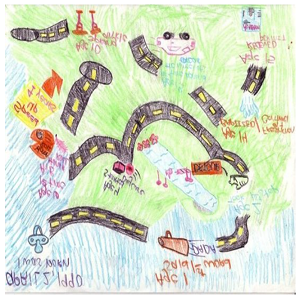
For use with: parent/carers, children aged 5-15 and young people aged 16-18
What is a life map?
A life map is a timeline of events from birth to the present. It involves the use of art, talking and charting to develop a visual map of the child’s life so far.
When would you use it?
Building a timeline of events from birth to the present can be a useful way of gaining an understanding of a family’s journey and the important events from their perspective. It can often be the first time that a family, or a parent or child has thought about their life in its entirety. It can therefore be both illuminating and challenging. Practitioners using this method should ensure that they have the time required to support the people involved emotionally as well practically during and after the process
How would you use it?
Before starting it is important to talk about what will happen to the life map at the end. Are you going to copy it, take it away, and use it for assessment purposes? The person you are working with needs to know this so they can make a choice about what to share.
1. Explain to the person what a life map is and that you will be helping them to build a timeline of events in their life from birth to the present. Your role is to facilitate the process by asking open questions, encouraging sharing and participation, and keeping the focus by reminding participants of the task and drawing attention to the passage of time that needs to be explored.
2. Provide equipment for the participants to use. At a minimum you will need pen and paper. The more creative the tools you supply, the more chance you will have of evoking a sense of permission to explore difficult subjects without speaking. Pens, paint, coloured paper, things to cut out, stickers, different textures such as feathers and cloth can all be useful.
3. Ask the person to draw a timeline and populate it with life events they determine to be significant. The timeline can take whatever form they choose.
4. Monitor the quality of the communication, the emotions that are being brought up by doing the piece of work, and adjust the task and the expectations accordingly. This might include frequent breaks, directing people to different tasks, or spending time listening to or supporting people as they remember difficult things.
5. Ensure that the life map is progressing in a timely manner. If you know that some of the more critical events happen near the end you might want to think about how to ensure enough time is left to explore those events well.
6. When the life map is complete make sure there is time to look at it as a whole. It is sometimes good to be able to place it on the wall or floor and get people to stand on chairs to look at the picture of their life. Allow people the space to look at it without making any comments. After five minutes or so you may want to ask an open questions like “what are you thinking right now?”
7. If you have had any insights or developed a hypothesis during the life map process you need to check them out. Ask the participants what strikes them most about their life? Ask them what surprised them? What did they already know? Once you have listened to all they have to say if they have not raised some of the things that you are thinking, you need to ask their permission to share some of your observations. For example, these are some of the things that I have been thinking about… what do you think?
8. Before ending the session, check in with the participant:
- What do they want to do with what they have explored or discovered?
- Do you need to follow anything up (referrals, visits, information that needs to be checked or found?)
- How do they feel about ending the session/what they found?
- What would they like to do with the work?
9. Finally, it is good to ask what they are going to do with the rest of their day – talk a little bit about the small tasks that make up life to bring them back into the present.
Example Life Map
This is an example of a child’s life map covering the age from when he was born up to the age of 15, although the map suggests that the road continues into the future.

